Gardner
Historical summary of Gardner.
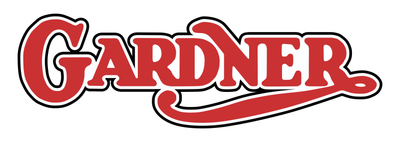
Early Beginnings of L. Gardner and Sons
L. Gardner and Sons Ltd., a titan of British engineering, began its journey in 1868 when Lawrence Gardner established a modest workshop in Hulme, Manchester, England. Initially focused on sewing machine production, the company quickly diversified, crafting everything from dental chairs to coffee roasters, showcasing early ingenuity. After Lawrence’s death in 1890, his sons—Thomas, Edward, Lawrence, Ernest, and Joseph—carried the torch, retaining the name L. Gardner & Sons to honor their father. By 1895, the company ventured into gas engine production, and in 1899, it relocated to the Barton Hall Engine Works in Patricroft, Manchester, a move that marked its ascent as an industrial powerhouse. Diesel engine production began around 1903, laying the foundation for Gardner’s legendary reputation in stationary, marine, road, and rail applications.
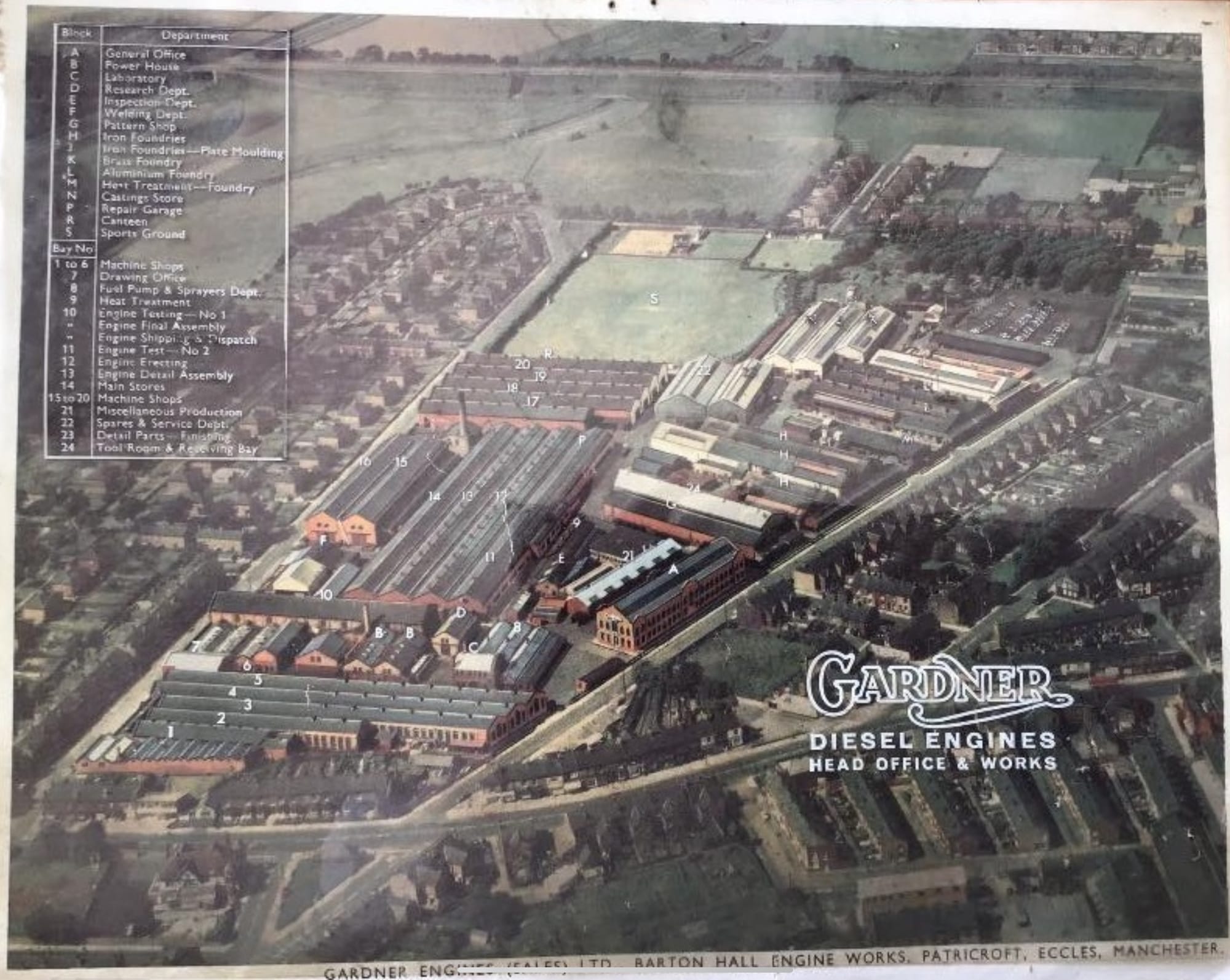
The early 20th century saw Gardner’s engineering prowess expand. During World War I, the company produced munitions, gun parts, and tank engines, cementing its role in national defense. The 1920s brought rapid advancements in diesel engine design, culminating in the 1929 installation of a Gardner 4L2 marine engine into a Lancia bus—a successful experiment that spurred the development of the LW series, tailored for road vehicles but adaptable for marine use. These engines, known for their modular design with cast iron cylinder blocks and aluminum alloy crankcases for road applications, powered luxury cars like Lagondas, Bentleys, and Rolls-Royces in the 1930s, earning praise for reliability, economy (achieving 30 mpg in a two-ton Bentley), and smooth operation.
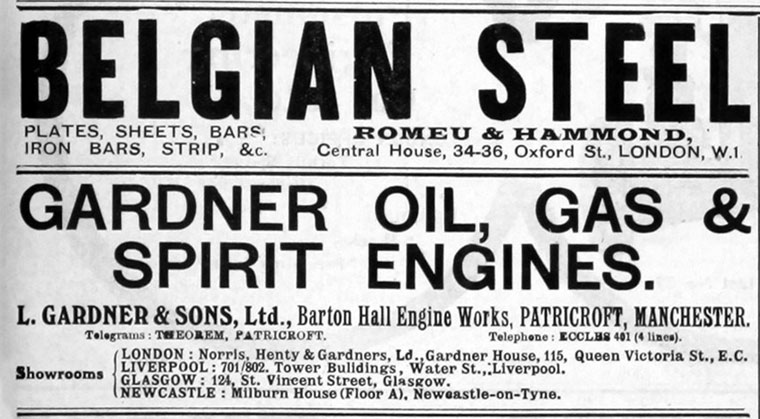
The Rise of the LX Series and Post-War Dominance
World War II saw Gardner focus on diesel engines for military applications, including the 4LK engine used in Royal Navy midget submarines. Post-war, the LW series continued to dominate in buses and lorries, but the introduction of the LX series in 1958 marked a pinnacle of engineering excellence. Designed by brothers Hugh and John Gardner, the 6LX, a 10.45-liter inline-six diesel, became the company’s flagship, renowned for its durability, efficiency, and refinement. Its cast iron cylinder block, alloy crankcase, and horizontally braced crankshaft bearings ensured exceptional strength, with warranty claims for terminal failure nearly nonexistent. The 6LX powered buses, trucks, cranes, locomotives, and marine vessels, becoming a global standard for reliability.
The 6LX evolved into the 6LXB in the late 1960s, boosting output to 180 bhp at 1850 rpm with a thermal efficiency exceeding 40%—a figure unmatched at the time. Its low specific fuel consumption (0.330 lb./bhp/hour) and torque delivery at 975–1100 rpm made it ideal for heavy-duty applications. The 6LXB’s reputation for longevity made it a favorite among bus operators, hauliers, and showmen, powering nearly 90% of British buses and a significant share of trucks by the mid-1980s. However, Gardner’s refusal to embrace turbocharging, led by Hugh Gardner’s conservative approach, began to limit its competitiveness as rivals like Cummins and Rolls-Royce offered higher-powered engines.
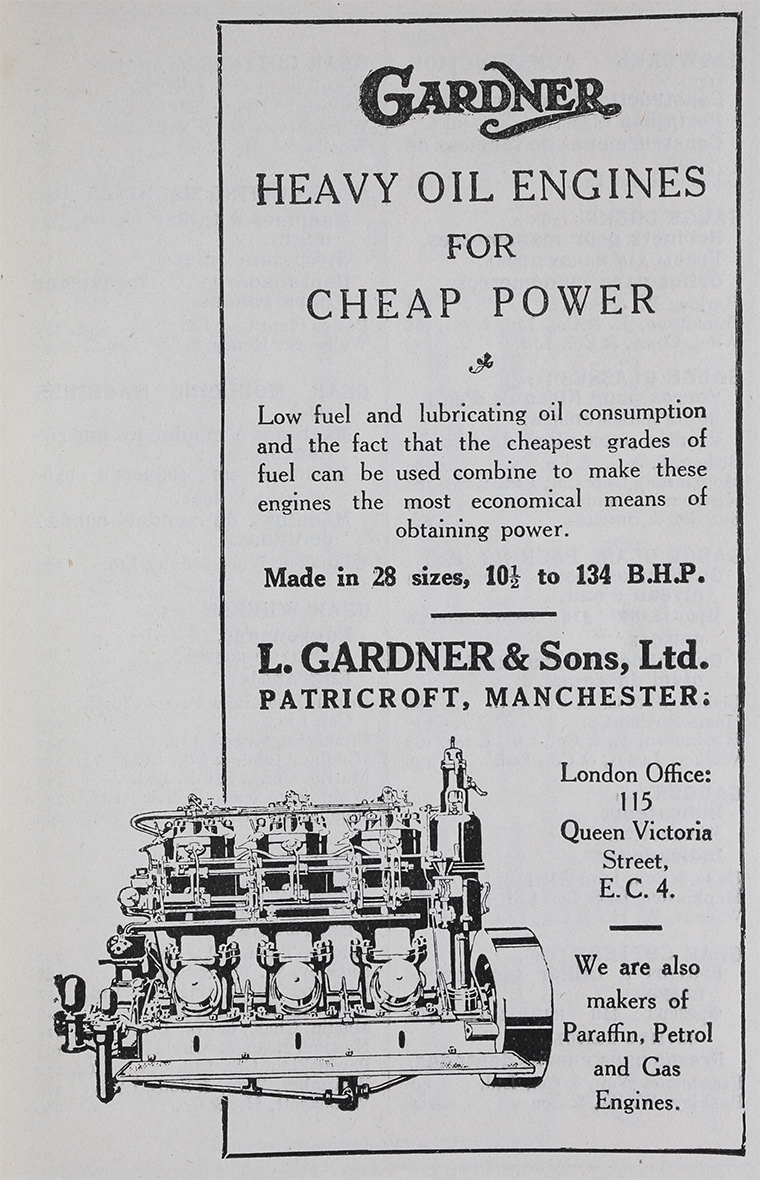
The 6HLX and 6HLXB: Horizontal Powerhouses
The 6HLX and its later iteration, the 6HLXB, were horizontal variants of the 6LX and 6LXB, designed primarily for underfloor mounting in buses and coaches, where their low profile maximized passenger space. Introduced alongside the vertical 6LX in 1958, the 6HLX shared the same 10.45-liter displacement and inline-six configuration, delivering 150 bhp at 1500 rpm in its initial tune. Its horizontal layout required specific adaptations, such as modified oil sumps and exhaust systems, but retained the same cast iron block, alloy crankcase, and robust bearing design. The 6HLX was celebrated for its smooth operation and fuel efficiency, making it a staple in municipal bus fleets, particularly in models like the Bristol VR.
By the late 1960s, the 6HLX evolved into the 6HLXB, mirroring the 6LXB’s upgrades. It produced 180 bhp at 1850 rpm, with 562 lb-ft of torque at low rpm, maintaining the 40%+ thermal efficiency that set Gardner apart. The 6HLXB’s horizontal design made it a preferred choice for bus manufacturers like Leyland, who, despite initial reluctance, adopted it for models like the National bus after failures with their own engines. Its reliability was legendary—Gardner engines in 24-tonne trucks and 32-tonne articulated lorries were virtually indestructible, even under grueling conditions. The 6HLXB also found marine applications, powering yachts and workboats with its low-speed, high-torque characteristics.
Decline and Legacy
Gardner’s dominance waned in the late 1970s as the company struggled to adapt to changing market demands. Hugh Gardner’s resistance to turbocharging and modernisation left the LX series underpowered compared to competitors. In June 1976, Rolls-Royce acquired a 17% shareholding in the business, but in 1977, Hawker Siddeley acquired Gardner, followed by Perkins Engines in 1986, aiming to bolster their lighter diesel range. However, Gardner’s truck market share plummeted, and production halted briefly in 1986. The early 1990s brought stricter emissions regulations and a marine market shift toward high-speed turbo-diesels, rendering Gardner’s low-speed designs obsolete. Engine production ceased by 1994, with the company focusing on spare parts and repairs.
Despite its decline, Gardner’s legacy endures. The 6HLX and 6HLXB remain iconic, with many still in use in preserved buses, marine vessels, and showman’s generators. Gardner Marine Diesels and Gardner Parts Limited continue to support these engines, supplying parts and refurbishing units for a global clientele. Enthusiast groups, like Gardner Enthusiast Ltd., manufacture obsolete components, ensuring the engines’ longevity. The Anson Engine Museum houses an extensive collection, preserving Gardner’s engineering heritage. The 6HLX and 6HLXB, with their unmatched efficiency and durability, stand as testaments to a golden era of British engineering, their cult-like following a nod to their status as some of the finest diesel engines ever built.
Technical Specifications of the 6HLX and 6HLXB
- Displacement: 10.45 liters (638 cu in)
- Configuration: Inline-six, horizontal, naturally aspirated diesel
- Bore & Stroke: 4.75 in x 6.0 in (120.65 mm x 152.4 mm)
- Power Output:
- - 6HLX: 150 bhp at 1500 rpm (initial tune)
- - 6HLXB: 180 bhp at 1850 rpm
- - Torque: 562 lb-ft at 975–1100 rpm (6HLXB)
- - Thermal Efficiency: Up to 40.73% (0.330 lb./bhp/hour fuel consumption)
- - Construction: Cast iron cylinder block, aluminum alloy crankcase, horizontally braced crankshaft bearings
- - Applications: Buses (e.g., Bristol VR, Leyland National), marine vessels, industrial equipment
- - Cooling: Fresh water closed-circuit heat exchanger or keel cooler (marine)
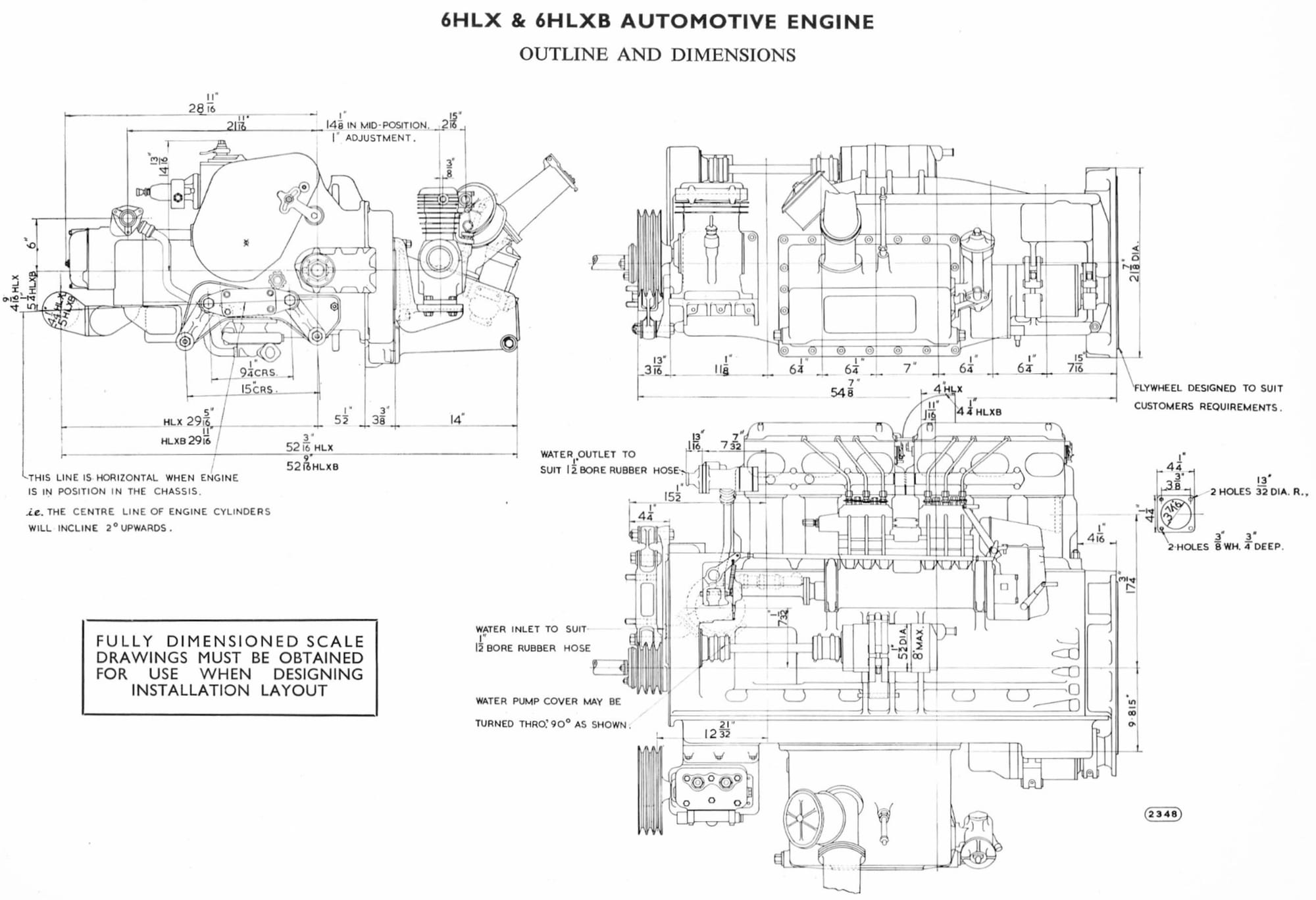 Images taken from the Operating and Maintenance Instructions for the Gardner Vertical and Horizontal Diesel Engines Manual
Images taken from the Operating and Maintenance Instructions for the Gardner Vertical and Horizontal Diesel Engines ManualEngine photographs

The Gardner 6LX vertical engine, referred to as 6HLX in CRG163 for its horizontal position
The following images are from the Gardner service manual and provides images of the 6LX as it would appear in its horizontal (HLX) form in CRG163.


Gardner promotional posters
Below is a collage of some of the promotional posters used by Gardner to promote its wonderful engines.
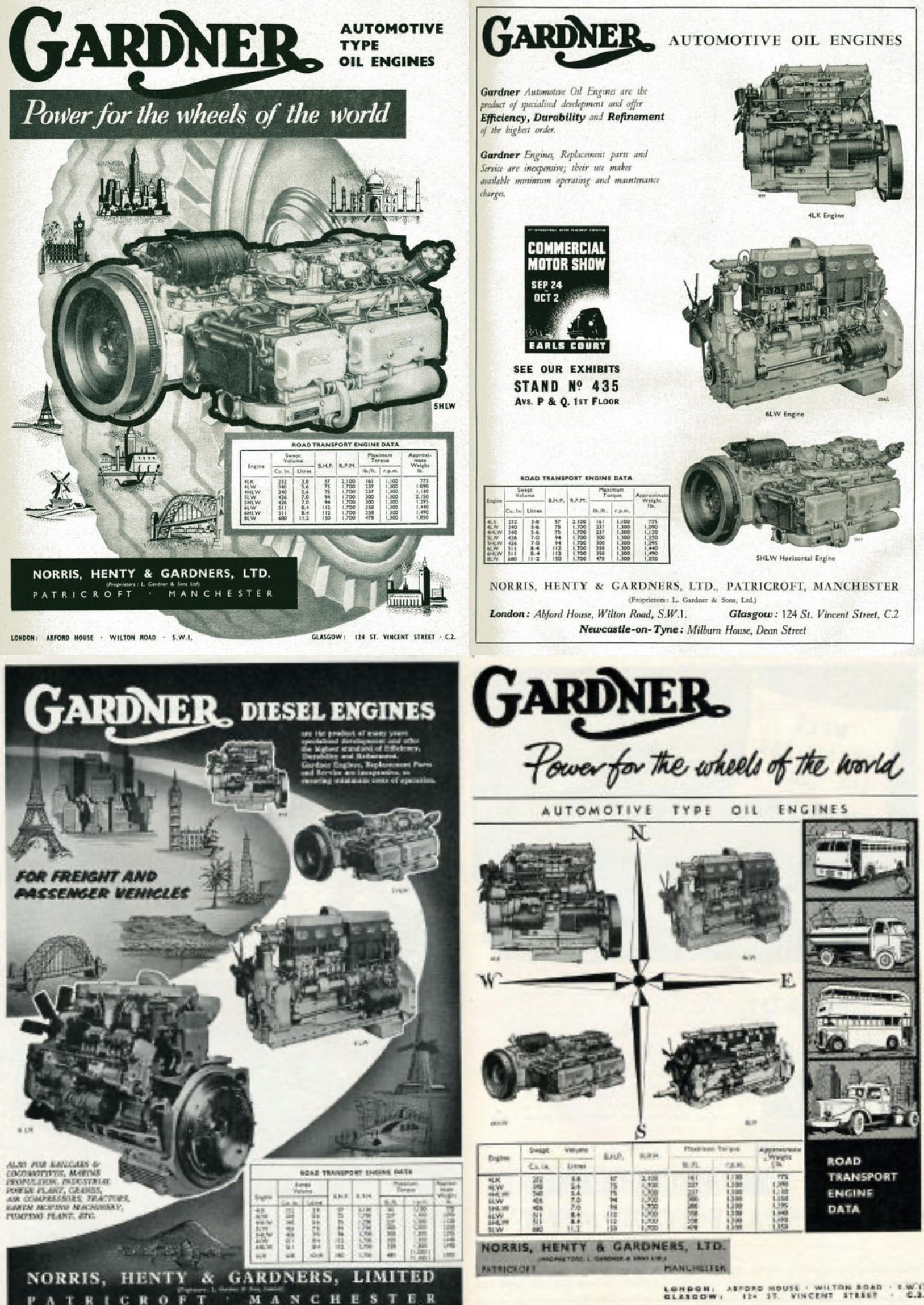
Gardner and the Bristol RE
The Bristol RE was frequently equipped with Gardner diesel engines, reflecting a significant connection between the two. As part of the Tilling Group’s policy to standardize diesel engines, Gardner engines became a staple for Bristol chassis, valued for their reliability, fuel efficiency, and durability. The Bristol RE, considered one of the most successful first-generation rear-engined buses, was commonly fitted with Gardner’s 6-cylinder engines, such as the 6LX and 6HLX (horizontal configuration), alongside Leyland engines like the 0.600 or 0.680. The Gardner engines were particularly favored for their robust performance, with models like the 6HLX delivering 150 bhp at 1,700 rpm, contributing to the RE’s reputation for longevity and operational efficiency. This preference was evident in various RE models, including the popular RELL and RELH, where Gardner engines were often specified, especially as production continued for operators like the National Bus Company and later for Northern Irish and New Zealand fleets.
The connection deepened due to practical and market factors. Gardner engines were noted for outperforming Leyland alternatives in certain conditions, such as maintaining speed on motorways, as observed in comparisons where Gardner-equipped REs reached destinations faster. However, supply constraints sometimes limited Gardner’s use, with Bristol Omnibus, for instance, standardizing on Leyland engines in the early 1970s due to Gardner’s inability to meet large-scale demand. Despite this, the Gardner engine’s reputation for indestructibility—demonstrated by their use in diverse applications from buses to marine and industrial settings—ensured their continued specification in REs, particularly for operators valuing fuel economy and low maintenance. The RE’s design, with its rear horizontal engine layout, was optimised for Gardner’s longer engines, though this sometimes posed challenges with rear overhang in shorter chassis variants. By the late 1970s, as emissions regulations and market shifts favoured smaller, high-performance engines, Gardner’s traditional designs waned, but their legacy in the Bristol RE endures in preserved vehicles and enthusiast circles.
The melodic sounds of the Gardner 6HLX as fitted to preserved Crosville CRG163 can be heard by clicking HERE.
Crosville and the Gardner engine
Crosville had a significant relationship with Gardner engines, which were renowned for their reliability and fuel efficiency, particularly from the 1950s to the 1980s. Gardner engines, especially the 6LX and its variants like the 6LXB, were favored by many British bus operators, including Crosville, for their durability and low-revving, high-torque characteristics, making them ideal for the demanding routes of Crosville’s network, which spanned urban and rural areas from Cheshire to North Wales. The company integrated these engines into various vehicle types, notably Bristol chassis such as the L, LL, and RELH models, with fleet numbering systems reflecting the Gardner engine through designations like “G” (e.g., CRG163, a Bristol RELH6G coach with a Gardner 6HLX engine). This preference persisted even after Crosville’s integration into the Tilling Group in 1942, which favored Bristol vehicles, as Gardner engines complemented the group’s focus on robust, standardised double-deckers and single-deck coaches.
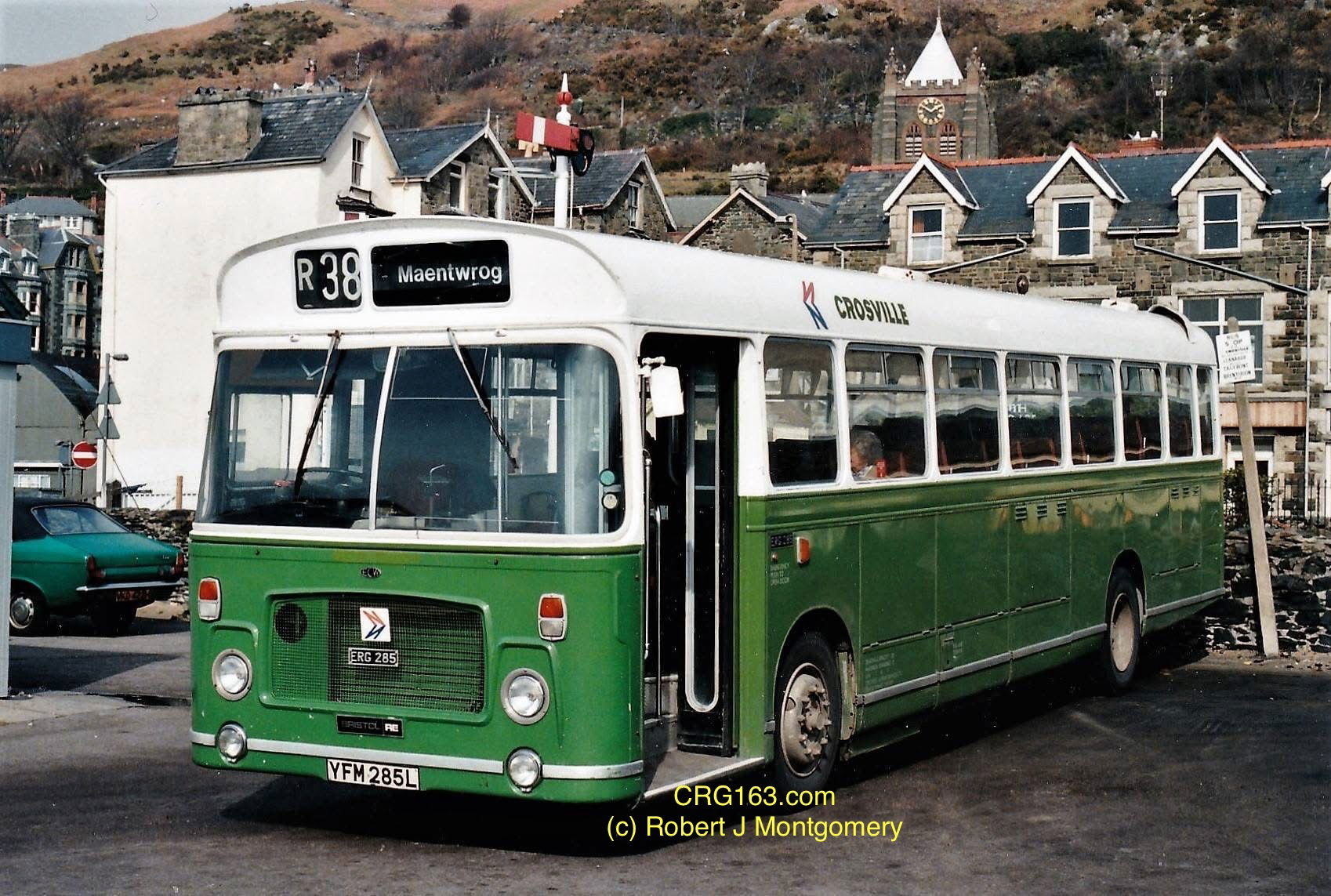 Crosville Bristol RELL6G ERG285 (YFM 285L) seen at Barmouth, 19 March 1986.
Crosville Bristol RELL6G ERG285 (YFM 285L) seen at Barmouth, 19 March 1986.The use of Gardner engines in Crosville’s fleet peaked during the post-war era and continued through the National Bus Company (NBC) period, with models like the Bristol VRT and Leyland National receiving Gardner engines in the 1980s, as seen in fleet reclassifications (e.g., ENL975-977 reclassified as ENG975-977 after Gardner engine fittings). However, Gardner’s reluctance to adopt turbocharged designs and increasing competition from manufacturers like Cummins led to a decline in their market share by the late 1980s. Despite this, Crosville’s fleet records show a sustained commitment to Gardner-powered vehicles, with many buses and coaches retrofitted or delivered with these engines due to their reputation for longevity. This relationship is further highlighted in preserved vehicles like CRG163, celebrated for its “magnificent” Gardner engine sound, underscoring the engine’s lasting legacy within Crosville’s operational history and enthusiast circles.
Crosville’s MW’s and the Gardner engine
Crosville Motor Services extensively utilised the Bristol MW (Medium Weight) bus, particularly in the 1950s and 1960s, as part of its diverse fleet. The Bristol MW, introduced by Bristol Commercial Vehicles in 1956, was a versatile single-deck bus or coach designed for both urban and rural routes, making it ideal for Crosville’s expansive network that stretched from Liverpool to Cardigan Bay. Many of Crosville’s MWs were fitted with the reliable Gardner engine, most commonly the 5HLW or 6HLW diesel variants, known for their durability and fuel efficiency. These buses, often bodied by Eastern Coach Works (ECW), were a mainstay for Crosville, with models like the CMG series (e.g., CMG 564, HFM564D) featuring the Gardner 6HLW engine, which provided a balance of power and economy for the operator’s demanding routes across varied terrains. The MW’s robust chassis and the Gardner engine’s reputation for longevity made them a favourite for both drivers and passengers, often seen on routes like the R26/R27 from Pwllheli to Porthmadog.
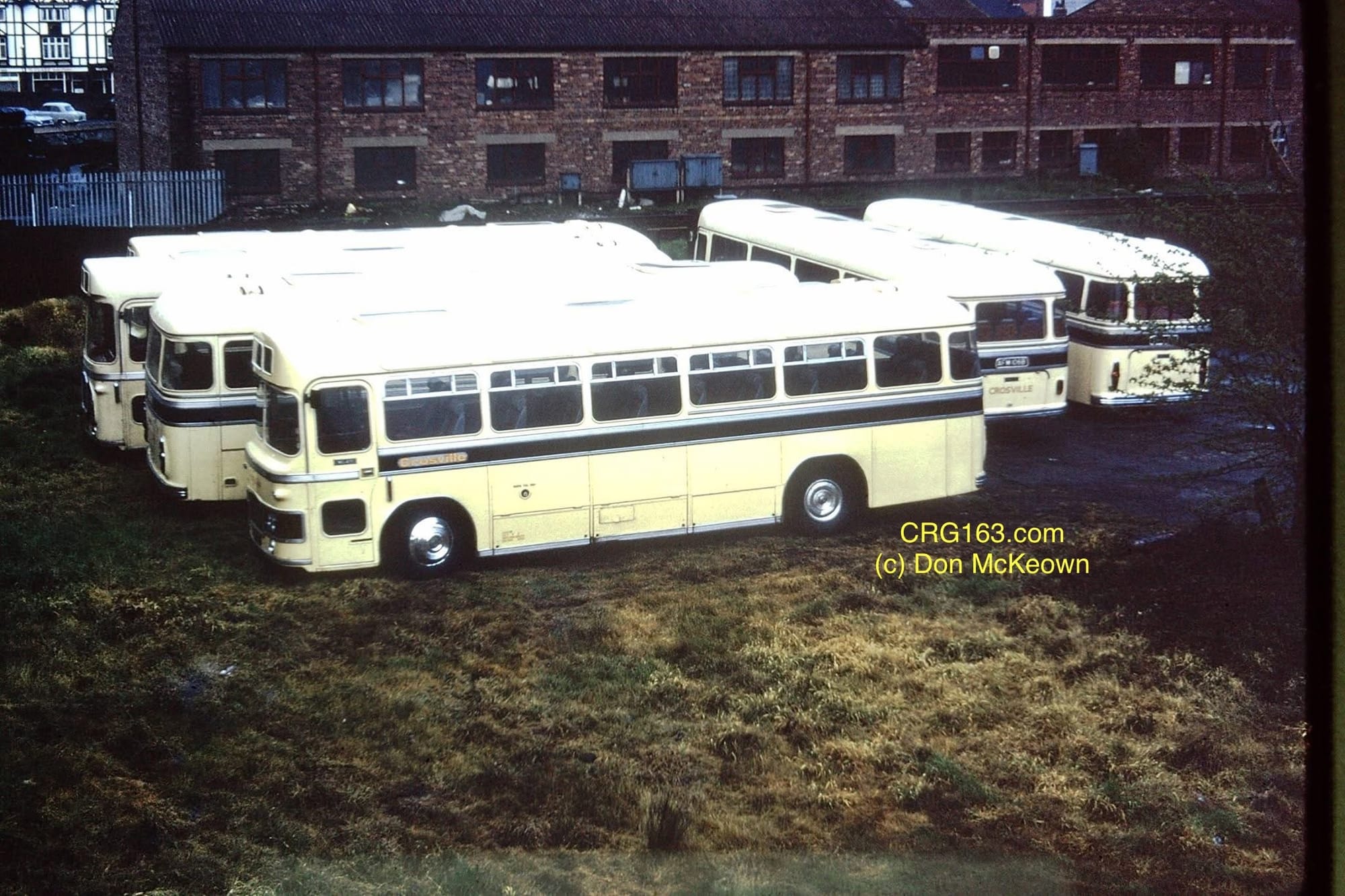 Crosville CMG’s in the beautiful and elegant cream and black coaching livery.
Crosville CMG’s in the beautiful and elegant cream and black coaching livery.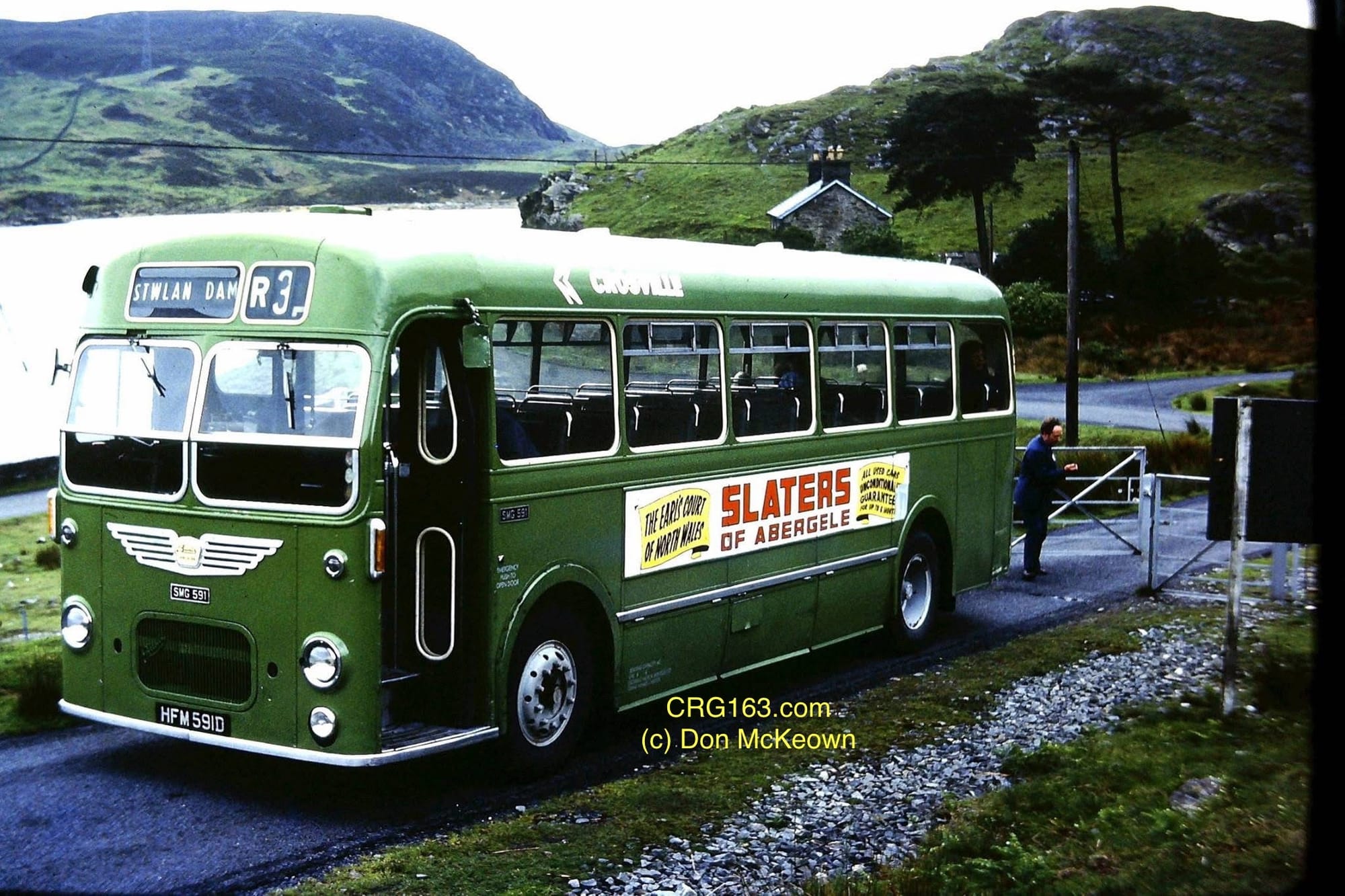 Don McKeown recalls, “SMG 591 on the Stwlan Dam service. The bus had just passed through the gate onto the private road; the driver is just locking the gate.”
Don McKeown recalls, “SMG 591 on the Stwlan Dam service. The bus had just passed through the gate onto the private road; the driver is just locking the gate.”The Gardner engine, particularly the 6HLW, was a cornerstone of the Bristol MW’s success for Crosville, offering a distinctive sound and performance that became iconic among bus enthusiasts. Known for its low-revving, high-torque characteristics, the Gardner engine ensured the MW could handle the challenging topography of North Wales, including steep gradients, with ease, albeit at a leisurely pace. Its fuel efficiency was a significant advantage for Crosville, which faced economic pressures during the 1960s and 1970s. The engine’s simplicity and ease of maintenance also aligned with Crosville’s operational needs, as the company managed a large fleet across numerous depots. The Gardner-powered MWs, with their green Tilling livery post-1945, remain a cherished part of Crosville’s legacy, symbolising an era of dependable, characterful bus travel.
Crosville, the Bristol VRT and Gardner 6LXB engine
Crosville Motor Services played a significant role in the operation of the Bristol VRT double-decker bus, particularly those fitted with the reliable Gardner engine. Crosville grew into a cornerstone of regional transport, becoming part of the Tilling Group in 1942, which standardised its fleet with Bristol chassis and Eastern Coach Works (ECW) bodywork. The Bristol VRT, introduced in 1967 as a rear-engined double-decker, became a staple for Crosville, aligning with the company’s need for robust, high-capacity vehicles to serve its extensive urban and rural routes. The Gardner 6LXB engine, known for its durability and fuel efficiency, was a popular choice for Crosville’s VRTs, offering the power and reliability needed for demanding services across cities like Liverpool, Chester, and seaside resorts in North Wales.
 DVG270 at Rainhill, Norland’s Lane on 19 April 1986. Robert comments “A fine vehicle for the H3, Edge Lane depot’s busiest route.”
DVG270 at Rainhill, Norland’s Lane on 19 April 1986. Robert comments “A fine vehicle for the H3, Edge Lane depot’s busiest route.”The Bristol VRT’s transverse-engined design (VRT standing for Vertical Rear Transverse) made it a versatile and modern option for Crosville, especially after the 1968 government grant favored transverse rear-engined buses for one-man operation. Crosville deployed these buses extensively, with many bodied by ECW, reflecting the Tilling Group’s influence. The Gardner 6LXB-powered VRTs were particularly valued for their smooth performance and low maintenance, as evidenced by their use in high-demand routes and even preservation efforts, such as the ex-Crosville Bristol VRT6L (DVL292) noted for its fleet plates and NBC livery in 1976. Despite early reliability issues with the VRT’s transmission and engine cooling, the Series 2 and 3 upgrades by the 1970s resolved these, making the Gardner-engined VRT a workhorse for Crosville until the company’s decline in the 1980s following deregulation. Today, preserved examples, like those in Crosville’s heritage fleet, highlight the lasting legacy of this iconic bus-engine combination in British transport history.
The Seddon Pennine RU
Crosville Motor Services significantly expanded its fleet in the early 1970s by incorporating the Seddon Pennine RU, a rear-engined single-decker bus, into its operations. In a notable departure from its long-standing preference for Bristol chassis and Eastern Coach Works bodies, Crosville placed a substantial order for 100 Seddon Pennine RU buses in 1970, as part of the National Bus Company’s fleet renewal strategy. These buses, delivered between April 1971 and May 1972, were powered by the reliable Gardner 6HLX or 6HLXB diesel engines, known for their durability and fuel efficiency. The first to arrive the Crosville fleet was SPG751 (KFM 751J). The order was split into two batches: 50 single-door buses with 47 coach seats for long-distance Anglo-Welsh services and 50 dual-door buses with 45 seats for intensive urban routes, reflecting Crosville’s diverse operational needs across its vast network from Cheshire to mid-Wales.
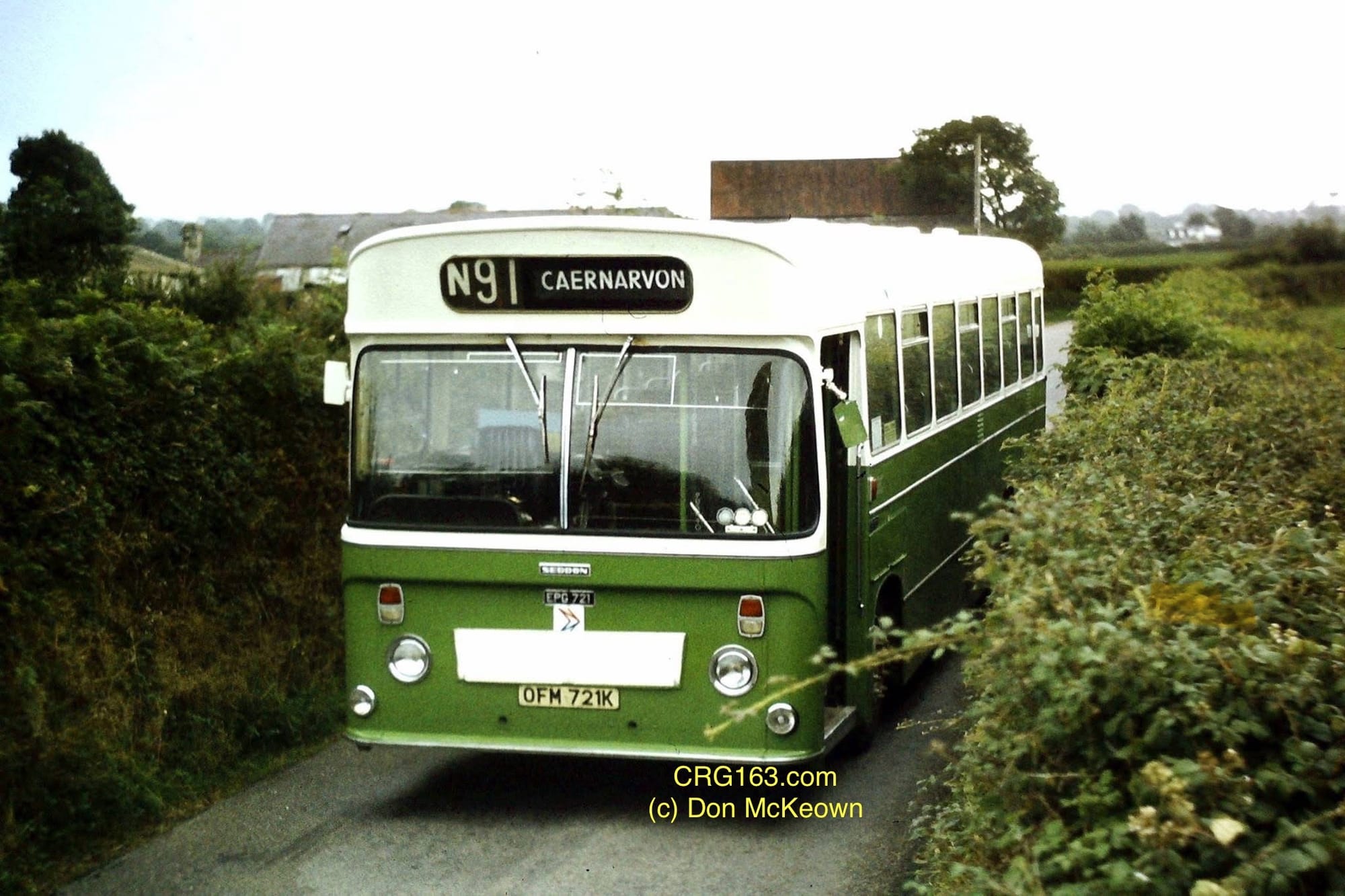 Crosville Seddon Pennine RU - EPG721 on route N91, Caernarfon - Dinas Dinlle. Don McKeown recalls that both Seddon Pennine RU’s based at the company’s depot in Caernarfon were also used on the Snowdon Sherpa service, and when not working on this service the headboard was still carried on the front of the bus, but the wrong way round as seen here.
Crosville Seddon Pennine RU - EPG721 on route N91, Caernarfon - Dinas Dinlle. Don McKeown recalls that both Seddon Pennine RU’s based at the company’s depot in Caernarfon were also used on the Snowdon Sherpa service, and when not working on this service the headboard was still carried on the front of the bus, but the wrong way round as seen here.The Seddon Pennine RU’s integration into Crosville’s fleet marked a strategic shift, driven by cost and production advantages, as the Seddon buses were priced lower than equivalent Bristol RE models and offered faster delivery from Seddon’s dedicated bus-production facility. The Gardner engines enhanced the buses’ appeal, providing robust performance for both rural and urban routes. Some Pennine RUs, like the demonstrator SPG699, were later fitted with Gardner engines in 1982, further extending their service life. Despite their operational success, the Pennine RUs faced criticism for vague handling and imprecise steering, yet they remained a significant part of Crosville’s fleet until withdrawals began in the early 1980s, with most gone by 1984. This adoption of Seddon Pennine buses with Gardner engines underscored Crosville’s adaptability during a transformative period in the British bus industry.
Gardner and the Leyland Olympian
Crosville Motor Services integrated Leyland Olympians into its fleet during the 1980s, notably for high-profile routes like the Cymru Coastliner, a limited-stop service connecting Chester and Caernarfon. Introduced in 1980, the Leyland Olympian was a double-decker bus designed to replace models like the Bristol VR and Leyland Atlantean, offering modern features such as air suspension and a semi-integral chassis. Crosville’s Olympians, including a batch of coach-seated vehicles (EOG-class) introduced in 1986, were tailored for comfort and efficiency on long-distance routes. These buses featured Eastern Coach Works (ECW) bodywork and were powered by Gardner 6LXB engine, being a popular choice due to its reliability and fuel efficiency. The Olympians’ striking liveries, such as the red dragon-adorned Coastliner design, made them visually distinctive, enhancing their role as flagship vehicles for Crosville’s Cymru Coastliner limited stop service.
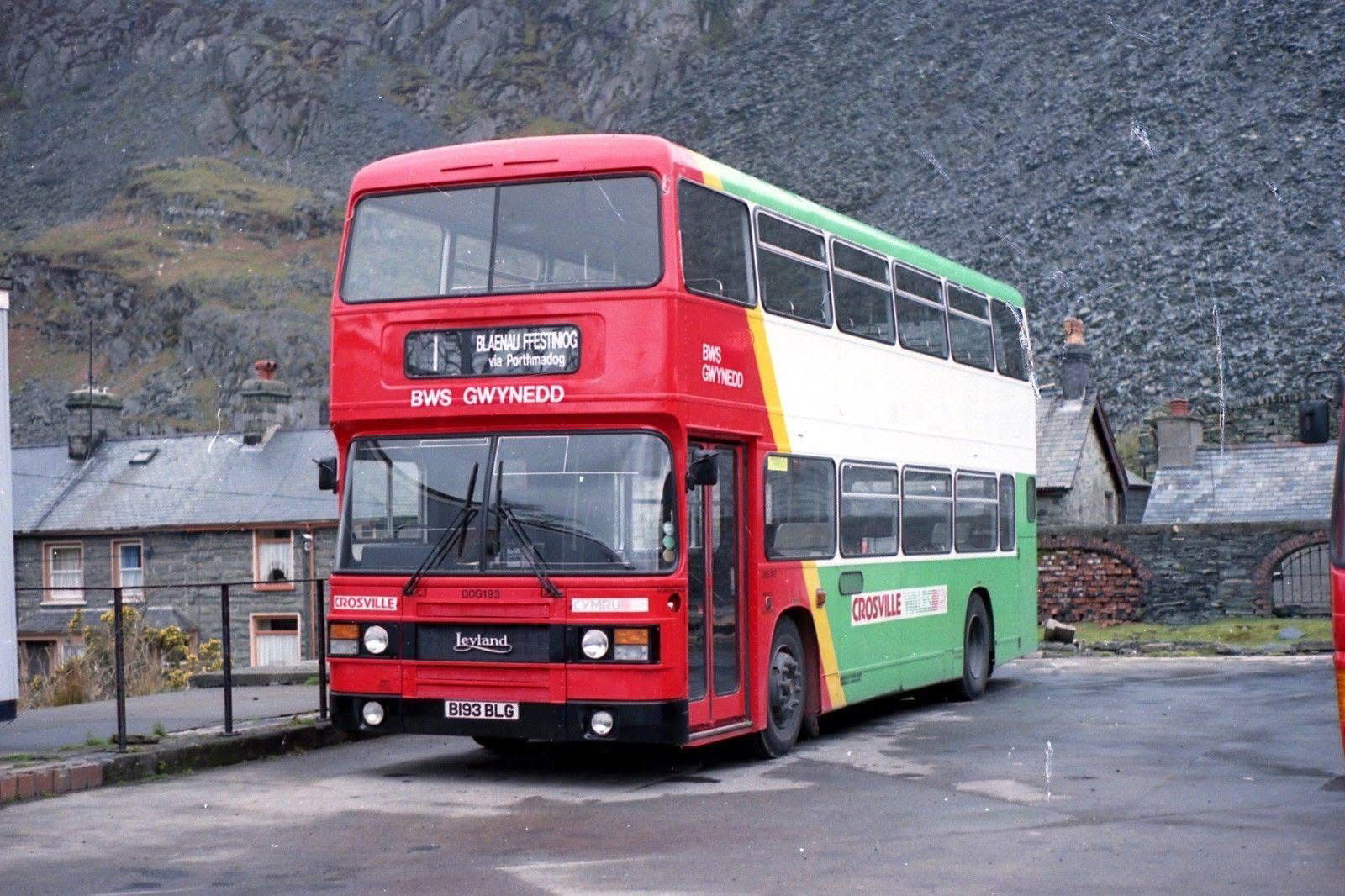 Crosville Wales Leyland Olympian DOG193 (B193 BLG). A favourite vehicle by many back in the day including myself. Seen here with the Bws Gwynedd red front, parked at the company’s Blaenau Ffestiniog depot.
Crosville Wales Leyland Olympian DOG193 (B193 BLG). A favourite vehicle by many back in the day including myself. Seen here with the Bws Gwynedd red front, parked at the company’s Blaenau Ffestiniog depot.The Gardner 6LXB engine, a 10.4-liter diesel unit producing around 180 bhp, was renowned for its durability and low-revving performance, making it ideal for the demanding schedules of Crosville’s routes. Its robust cast-iron construction and horizontally braced crankshaft ensured exceptional longevity, often outlasting the buses themselves. The engine’s thermal efficiency, close to 40%, and maximum torque at low RPMs (975–1100 rpm) provided steady power and excellent fuel economy, critical for operators like Crosville facing economic pressures post-deregulation in 1986. While some Crosville Olympians later adopted Cummins L10 engines or ZF gearboxes, the Gardner-equipped models were favored for their predictable power delivery and minimal maintenance needs. However, by the early 1990s, stricter emissions regulations forced the Gardner’s retirement, as it couldn’t meet new standards without significant redesign, marking the end of an era for these reliable powerhouses in Crosville’s fleet.
Crosville’s Leyland National Gardner engine conversions
In the early 1980s, Crosville Motor Services faced operational challenges with their fleet of Leyland Nationals, known for their reliability but also for the fuel inefficiency of their original Leyland 510 engines. To address this, Crosville initiated a conversion program to replace these engines with more economical Gardner 6HLX diesel engines, sourced from their withdrawn Seddon Pennine RU buses. The Seddon Pennine RUs, powered by Gardner engines, had been a significant part of Crosville’s fleet since the early 1970s, with the company operating 100 of these rear-engined single-deckers. By 1981, as some RUs reached the end of their service life due to expired certificates of initial fitness, Crosville saw an opportunity to repurpose their robust Gardner engines, which were renowned for their durability and fuel efficiency, into the Leyland Nationals to enhance performance and reduce operating costs.
The conversion process involved significant engineering adjustments, as the Gardner 6HLX engines were integrated into the Leyland National chassis, which required modifications to accommodate the different engine characteristics. This initiative was part of Crosville’s broader strategy to maintain a cost-effective and reliable fleet amidst the economic pressures of the time. The Gardner-powered Nationals proved successful, offering improved fuel economy and aligning with Crosville’s preference for Gardner engines, a trait shared with other operators like the Scottish Bus Group. This conversion not only extended the operational life of the Leyland Nationals but also highlighted Crosville’s innovative approach to fleet management, leveraging their existing resources from the Seddon Pennine RUs to adapt to changing operational demands in the 1980s.
Such conversions was covered in COMMERCIAL MOTOR on 30 March, 1985. Click HERE to go to the on-line article on the Commercial Motor Archive website.
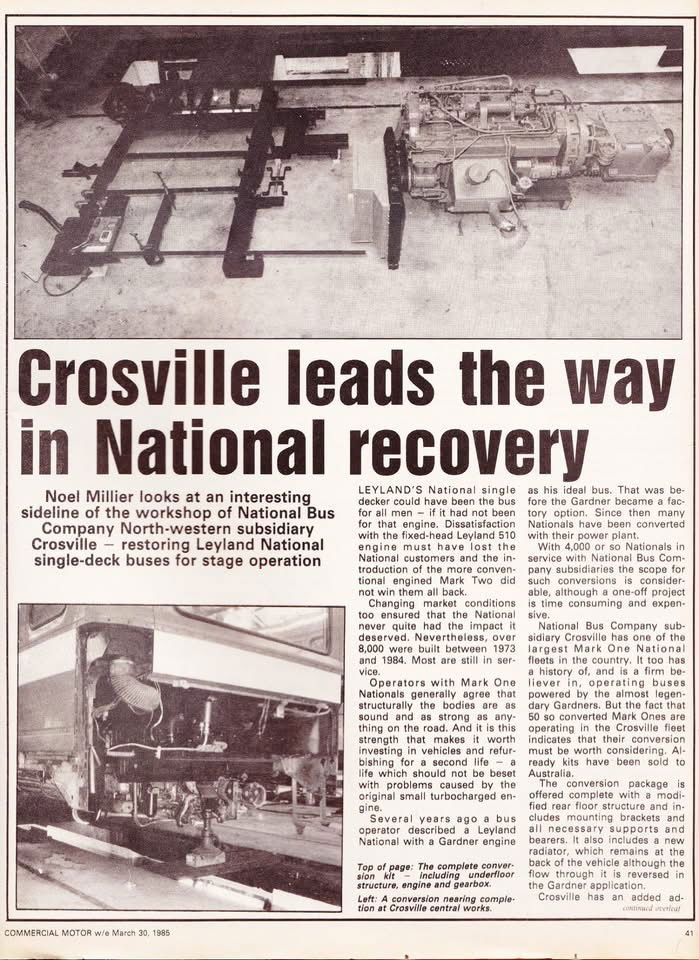
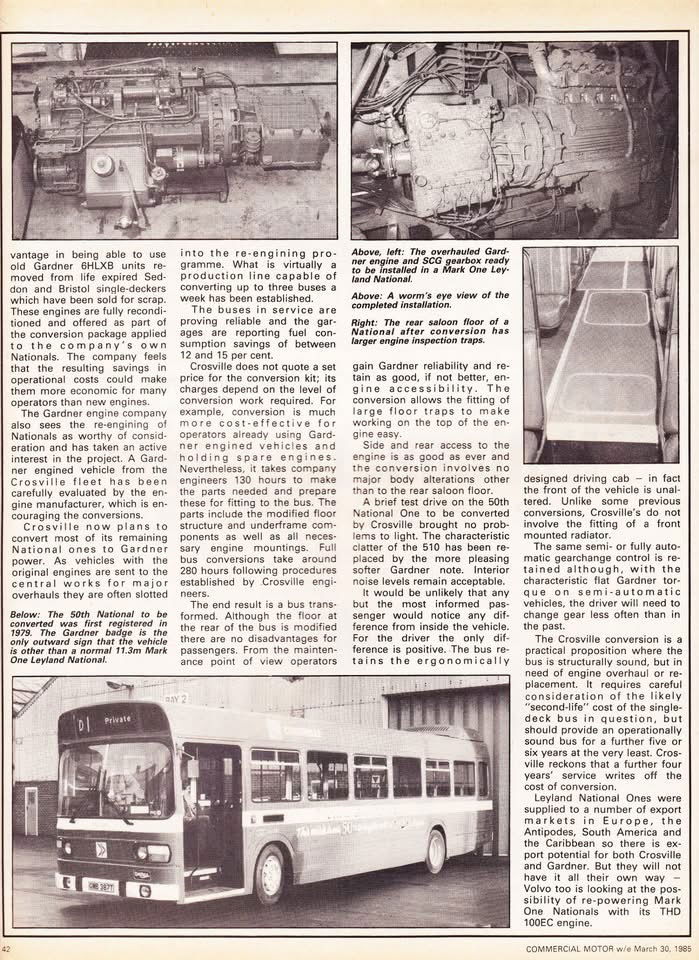
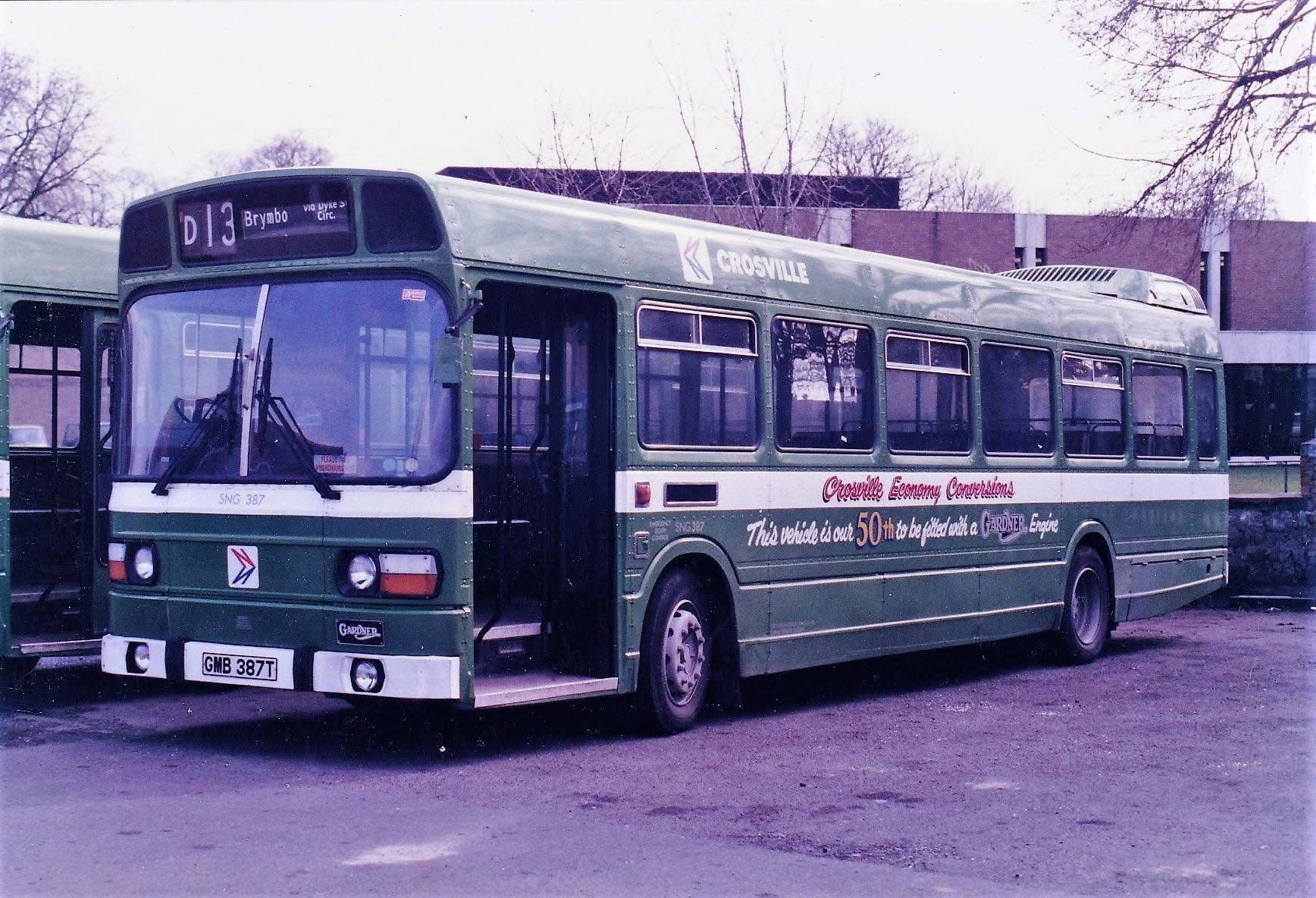 Crosville’s 50th Gardner Leyland National conversion. SNG387 is seen at Wrecsam on 19 March 1986.
Crosville’s 50th Gardner Leyland National conversion. SNG387 is seen at Wrecsam on 19 March 1986.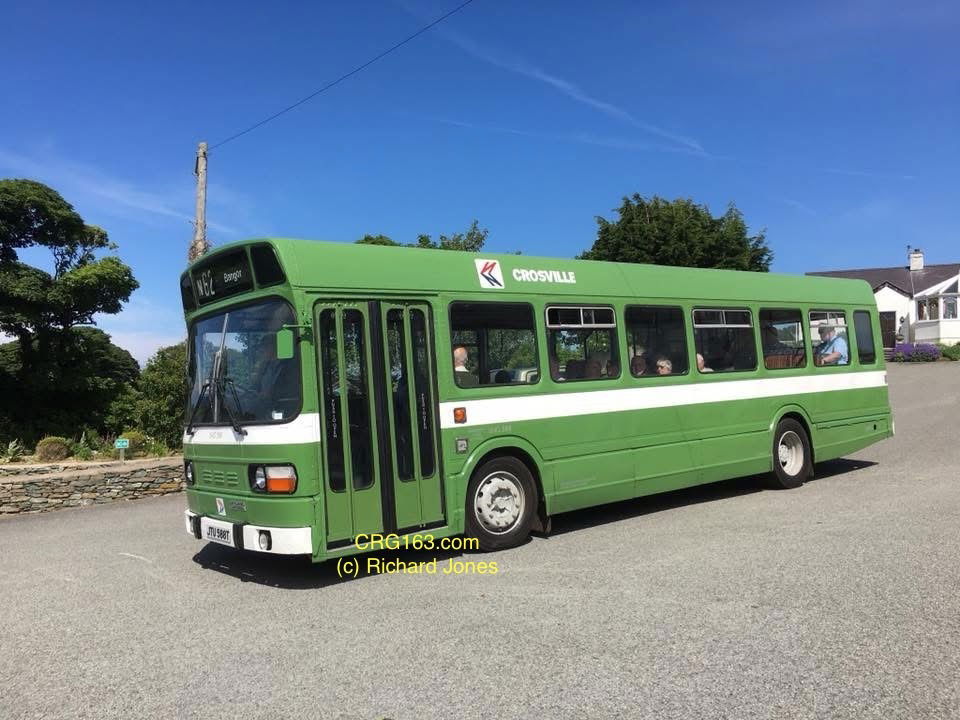 Preserved Crosville Leyland National B - SNG588 (JTU 588T) - photo taken in 2016.
Preserved Crosville Leyland National B - SNG588 (JTU 588T) - photo taken in 2016.Click HERE to see a short video of preserved Crosville SNG588 accelerate away in 2016 (the same day as when the above photograph was taken) demonstrating fully the fantastic sound of the superb Gardner 6HLXB as one of the Leyland National B’s converted by the company during the mid 1980’s. This vehicle is preserved by Andrew Hammer and is a superb example of this type of vehicle.
Can you help?
If you have any photos or related information about CRG163 or any information on the parts presently required then please e-mail me, Richard Jones at post@crg163.com . Many thanks in advance.
You can also subscribe to this website by entering your e-mail address into the white box below, bottom right and click the subscription button. ⬇️
